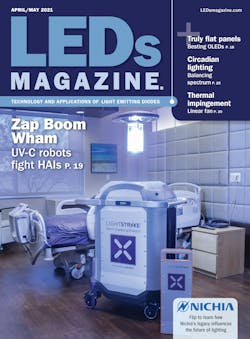Larger harvests for reduced costs, time, and effort are what nearly all indoor cannabis growers yearn for. Indoor grow operations have made great strides in increasing yield through various techniques, but technological innovations are needed to advance indoor growing to the next level.
Increasing light intensity to get higher yields is an established strategy, but technological limitations have put an artificially low barrier in place.
Traditional high-pressure sodium (HPS) lights put out a lot of infrared (radiated heat) and mostly yellow light. Chlorophyll, the pigment responsible for photosynthesis, cannot use yellow light directly, which forces plants to use other pigments to convert yellow photons to red ones that chlorophyll can use, releasing heat in the process. These two mechanisms combine to put limits on how intense HPS lights can get before leaves overheat. This is why plants under HPS lights can’t tolerate temperatures much above 80°F; however, active cooling increases HVAC costs.
Cannabis plants grown with natural sunlight receive a much broader spectrum comprising lots of red and blue light, allowing them to thrive with temperatures over 90°F, and some even over 100°F. New LED technology delivers the proper spectrum more efficiently, driving photosynthesis and keeping plants cooler while increasing light levels beyond what they can tolerate with HPS. This can enable increased yield per square foot while lowering cooling needs and costs.
Plants respond to various wavelengths of light, and ratios or mixes of light, by growing differently in a process called photomorphogenesis. Abundant red without enough blue causes plants to stretch and grow their stems longer. This is why plants get “leggy” under HPS lights and why metal-halide (MH) lights have traditionally been used for vegetative growth, as the plants simply become too tall and “floppy” under HPS. The ratio of far-red to red and red to blue also controls leaf size.
With LED lighting, we can tune the spectrum to tailor the plants’ growth to our desires, keeping leaves smaller, stems shorter, and leave more of the plants’ limited growth energy for producing larger flowers and more of them, instead of stems and leaves. Shorter stems also create smaller, bushier plants. This means more can fit in an area to increase yield per square foot. By tailoring plant growth with carefully tuned spectra, we can make plants produce more of what we want and less of what we don’t.
Canopy penetration — how far light can travel in a dense mass of leaves and flowers — also affects yields. Higher light intensity means better canopy penetration, and LEDs with a spectrum designed to allow higher light intensity without overheating the leaves can achieve this. However, canopy penetration also depends on the light’s wavelength, as some colors of light can travel through leaves better than others. Photons often lose energy when bouncing off or traveling through leaves, shifting them to a higher-wavelength (redder) light. Once the light is shifted past red, plants can’t use it for photosynthesis anymore. Starting with higher-energy (shorter-wavelength) ultraviolet-A and deep-blue photons allows them to bounce more times and go through more leaves before becoming ineffective for photosynthesis.
This deeper canopy penetration nourishes lower leaves and provides more energy for plants to grow high-quality, dense flowers much lower on the plants. However, many modern light fixtures don’t emit UV and deep-blue light. Creating higher-energy photons requires more electricity than lower-energy photons, making lights that create UV and deep-blue light less electrically efficient per photon created, so they look worse on paper. However, the increase in yield per square foot more than makes up for the decreased electrical efficiency.
Light isn’t the only factor for maximizing cannabis yields, but it is certainly one of the most critical. LEDs are vastly more energy efficient than conventional technologies, and most modern LED grow lights have a much better spectrum for growing plants than HPS or MH lights. However, simply maximizing the amount of light distributed to a plant or looking only at the number of photons a light can generate per watt ignores one of the most exciting tools that LED technology can provide — customizable spectra.
By carefully tuning the spectrum output to plants, we can control their responses to maximize yields. Spectrally-tuned LED lights containing UV-A, deep-blue, and the right ratios of reds and blues can maximize light intensity and canopy penetration, which are the keys to the future of increasing yields in indoor cannabis gardens — all while reducing overall electrical and cooling costs.
Get to know our expert
KEVIN FRENDER is chief science and technology officer of Black Dog LED. With 8 years of experience at the company, and 35 years’ experience as an indoor grower, he has cultivated a vast knowledge base of artificial lighting technologies.
Enjoyed this article? Visit our digital magazine for more like this >>






